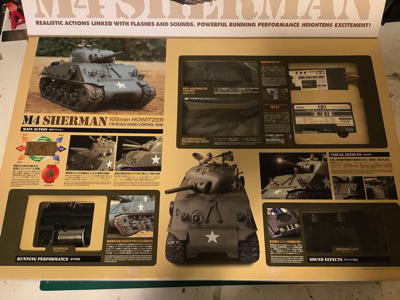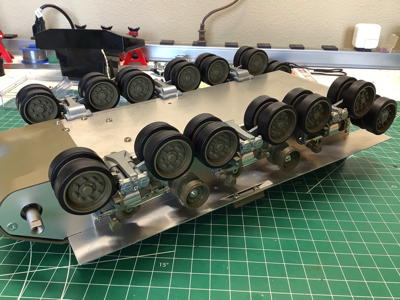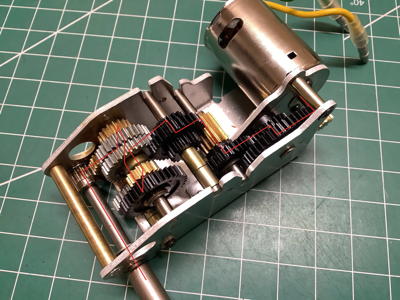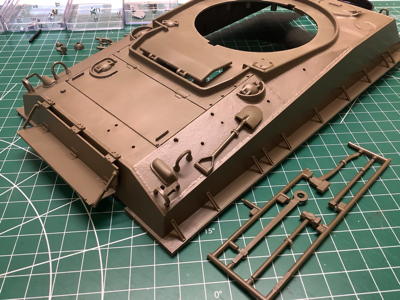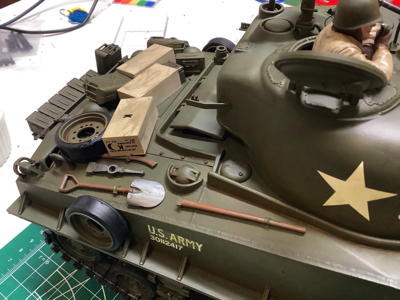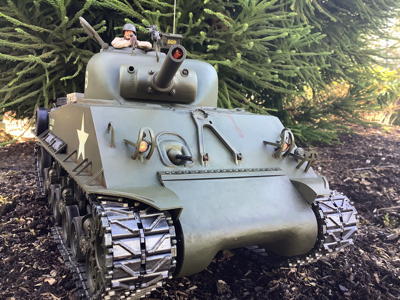Tamiya M4 Sherman Project
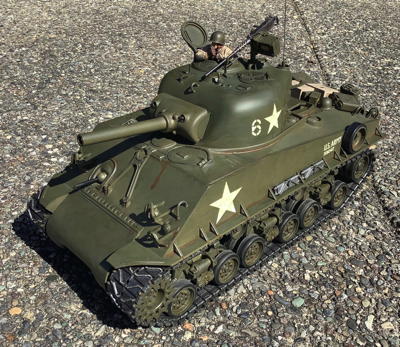
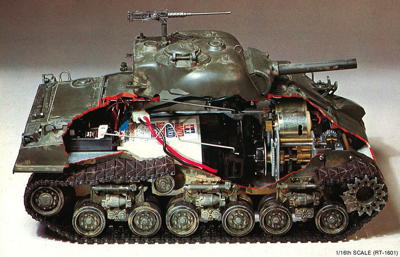 A Bit of Tamiya Tank History
A Bit of Tamiya Tank History
Many Tamiya fans believe that the first Tamiya RC was the 58001 Porsche 934 Turbo RSR. While that was indeed the first RC car, the first Tamiya RC of all was the 56001 M4 Sherman tank
model two years earlier in 1974 (it was called RT-1601 at the
time). The model was designed by Dr. Fumito Taki who had recently
transferred from the accounting department. The original idea was
to use the German Maus tank as the subject, but they soon learned that
due to the tank geometry it wouldn't turn well and the tracks would
easily get clogged with debris. They needed something short and
driven by the front sprockets which gripped the tracks at the outer
edge. This made the M4 Sherman the only viable option. The
other advantage of the Sherman was that some uncommon versions used a
105mm howitzer instead of the standard 75mm cannon, and this short
barrel would be less likely to hit obstacles, making it more suitable
for a running model. So Dr. Taki headed off to the garrison at
Higashifuji to measure the real thing for a scale model. After
making a few mockups from wood and clay, he proceeded with the gearbox.
In these earliest days of RC,
proportional controllers scarcely even existed. For that reason,
the original Sherman tank was basically a static model with a gearbox
that could be built using 0-2 channels (cutaway shown at upper
left). The gearbox had two sides like a skid steer which could be
connected independently to two 360 sized motors or connected in parallel
sharing a single spur gear. Each gearbox side had a clutch at the
forward end
which was spring loaded to grip the input gear. However, if the
front of the clutch housing were pushed forward it would gradually
release the input gear and connect to ground instead. In the
simplest setup, the motors were just connected in parallel with no RC at
all. The model could
simply be turned on and off and would drive forward when on.
Because the left and right sides were hard coupled together, it would
drive straight. The one channel version was intended to use the
old controllers with one toggle button. In this configuration the
motors were connected to each side separately. It would drive
straight forward until the
button was pushed which would simply disengage the left hand motor
causing a turn. Stopping, turning right, and going backward were
not possible. Even the most deluxe configuration was still very
electronically simple (but mechanically complex). A proportional
servo was used for steering. It was connected to a wide crank
which could contact either clutch, so by rotating the servo either side
was gradually disengaged and then grounded. This allowed
proportional turns all the way to stopping one track. Pivot
turning was not possible. Incidentally, many early tanks used a similar clutch and brake turning system. The
prototype gearbox was made by Dr. Taki himself on a lathe. It
worked perfectly and even allowed him to attempt a version with a water
cooled engine. There were no speed controllers yet, not
even mechanical, so there was no proportional throttle. Instead,
another servo just contacted either a forward or reverse switch.
This means the model could be stopped, full forward, or full
reverse. This was the full extent of the controllability. No
remote control of the turret or barrel was possible. In terms of
scale realism, the real 105mm didn't have powered turret traverse or
elevation, so the lack of these features on the model is actually
correct.
Tamiya made three more RC tanks over the next few years (Leopard A4,
Flakpanzer Gepard, and King Tiger) which each progressed a bit in terms
of technology. The Leopard used the same gearbox but switched to a
single 540 motor. The Gepard used the same thing but added a
proportional mechanical speed controller and an optional 3rd channel
with it's own battery that rotated the turret, elevated the guns, and
rotated the search radar all at the same time. The Tiger used a
modified version of the same gearbox, a rotating turret, and a strobing
light in the barrel. This 4-channel version was the most deluxe
tank of that original generation. Then things went quiet for 18
years!
In 1998 Tamiya finally came out with a "new" tank, and for this new
generation the M4 Sherman was the first choice again. Outwardly
this new 56005
Sherman was indistinguishable from the original, using all the same
plastic body parts and suspension. Inside, however, everything was
different. A pair of new gearboxes using 380 motors was
introduced. These gearboxes lasted a long time. They were
used in new tank models up until 2016 and are all still sold
today. The real revolution though was the DMD (Dual Motor
Differential), a twin motor electronic speed control box. Using
this controller, power to each gearbox could be modulated
separately. The transmitter signals were mixed inside the DMD
allowing the driver to use standard throttle and steering controls
instead of skid steer. It was still a 2-channel model though with
no turret control.
There were only two models
in this second generation before the next leap forward. The next
thing Dr. Taki wanted to do was add sound. He originally intended
to just add sound to the existing King Tiger to improve sales, but
Tamiya's boss suggested doing something totally new. The Tiger I
in 2000 added a Multi-function Unit (MF-01) to the DMD. Not only
did this add two more proportional channels for turret rotation and gun
elevation, it also added sound effects, lighting, gun recoil, and muzzle
flash. Every 1/16 Tamiya tank since then has used a variation of
this system. The sounds were recorded from a real Tiger tank by an
employee on a trip to the toy fair in Nuremberg who was asked to take a
side trip to the Saumur Museum in France to record the sounds.
Amazingly, they were willing to start it up for him and let him record
the sounds! It was only a year later (2001) when the Sherman came
back for its third and ultimate configuration. This is like the
Special Editions of the Star Wars movies. It is the version that
Dr. Taki always wanted to make but didn't have the technology at the
time. The 56014
Sherman used the same body and gearboxes as the 2nd generation, but
added all the new sound and turret functions. This is the version I
have.
The Tamiya M4 Sherman 105mm Howitzer
This particular version of the M4 Sherman selected
is pretty unusual. The M4 was made in at least 19 different versions
over a period of just two years. The Tamiya version is recognizable by
the combination of the 105mm howitzer, the HVSS (Horizontal Volute
Suspension System), and the radial engine. 841 out of a total of almost 50,000 were made in
this configuration at the Detroit Tank Arsenal.
So what does "Horizontal Volute" mean? This refers
to the springs used in the suspension. Most suspension uses coil
springs but these have some big disadvantages for tanks. Because of the weight a very large wire diameter is needed which
means the solid height of the spring is very tall and therefore the
suspension has hardly any travel. A volute spring is made in a tapered
spiral out of wound rectangular bar stock. Because it is tapered, it
nests when compressed and has much more travel. Most M4s were made with
the volute springs arranged vertically, but a few later models used
horizontal springs connected to pivoting bogies mounted in pairs. The
system used in the model is made to represent HVSS although it actually
uses coil springs hidden inside cans to simulate volute springs.
Early versions of the M4 Sherman used a 75mm cannon which was later
upgraded to a higher velocity 76mm version. Even less common were
the versions armed with a 105mm howitzer which was really intended for
use against infantry rather than other tanks. The model uses the
105mm version for the reliability of the short barrel in an RC application.
There were also a wide range of engines used in the M4 Sherman.
The model represents a version using a 15.98 liter 9-cylinder radial
engine from Wright Aeronautical. The distinctive sound of this
engine was recorded for the model. The sound is contained in the
MF-02 unit which is unique to this model. The DMD T-05 is also
unique to this model.
There were also variations of the Sherman in different combinations
of cast and welded hulls. The square sides of the model represent
the welded hull version.
The kit was available in two versions, one with a radio and one
without. By the time I was looking, I could only find one so I
ended up with a 27MHz AM radio I will never use. It was still
worth it. This tank is awesome. It turned out to be
everything I hoped. I don't know how they can make it better, so
I'm betting against a fourth version. Everything can be controlled remotely using only a 4 channel
transmitter. Remote functions include throttle, steering, turret
rotation, gun elevation, main gun firing, machine gun firing, and turning
lights on and off. Most functions are accompanied by sounds which are
automatic. Speed and power is
good despite the small motors.
Description
|
Manufacturer
|
Model #
|
M4 Sherman 105mm Howitzer
Full Option Kit
|
Tamiya
|
56013
|
380 Brushed Motor x2
|
Tamiya
|
7435122
|
4 Channel 2.4 GHz Receiver
|
Futaba
|
R204GF-E
|
TS-5 Olive Drab Paint x2
|
Tamiya
|
85005
|
 A Bit of Tamiya Tank History
A Bit of Tamiya Tank History